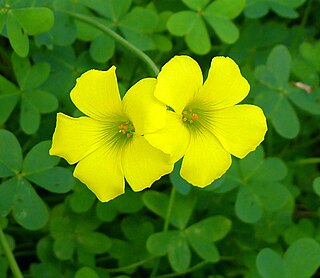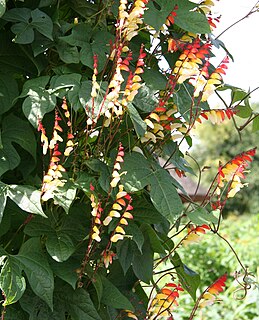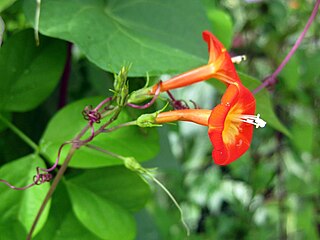
Morning glory is the common name for over 1,000 species of flowering plants in the family Convolvulaceae, whose current taxonomy and systematics are in flux. Morning glory species belong to many genera, some of which are:

Ipomoea is the largest genus in the flowering plant family Convolvulaceae, with over 500 species. It is a large and diverse group with common names including morning glory, water convolvulus or kangkung, sweet potato, bindweed, moonflower, etc.

Ipomoea alba, sometimes called the tropical white morning-glory or moonflower or moon vine, is a species of night-blooming morning glory, native to tropical and subtropical regions of the New World, from northern Argentina north to Mexico, Florida and Puerto Rico. Though formerly classified as genus Calonyction, species aculeatum, it is now properly assigned to genus Ipomoea, subgenus Quamoclit, section Calonyction.

Oxalis pes-caprae is a species of tristylous flowering plant in the wood sorrel family Oxalidaceae. Oxalis cernua is a less common synonym for this species.

Ipomoea pes-caprae, also known as bayhops, beach morning glory or goat's foot, is a common pantropical creeping vine belonging to the family Convolvulaceae. It grows on the upper parts of beaches and endures salted air. It is one of the most common and most widely distributed salt tolerant plants and provides one of the best known examples of oceanic dispersal. Its seeds float and are unaffected by salt water.
Beach morning glory is a common name for several plants and may refer to:

Ipomoea cairica is a vining, herbaceous, perennial plant with palmate leaves and large, showy white to lavender flowers. A species of morning glory, it has many common names, including mile-a-minute vine, Messina creeper, Cairo morning glory, coast morning glory and railroad creeper.

Ipomoea lobata, the fire vine, firecracker vine or Spanish flag, is a species of flowering plant in the family Convolvulaceae, native to Mexico and Brazil.

Moʻomomi is a Nature Conservancy preserve located on the northwestern shore of Molakaʻi in Hawaii. It was established in 1988. This area is dry and hot, primarily denuded of soil due to overgrazing and poor land use practices over the last 150 years.

Ipomoea triloba is a species of Ipomoea morning glory known by several common names, including littlebell and Aiea morning glory. It is native to the tropical Americas, but it is widespread in warm areas of the world, where it is an introduced species and often a noxious weed. This is a fast-growing, vining, annual herb producing long, thin stems with ivy-like, petioled, heart-shaped leaves 2.5–6 centimetres (0.98–2.36 in) long. The leaves sometimes, but not always, have three lobes. The vines produce tubular bell-shaped flowers, each about two centimeters long. They are quite variable in color, in shades of pink, red or lavender, with or without white markings.

Senecio crassiflorus, one of the native South American Senecio and an herbaceous dune dwelling perennial.

Juncus acutus, the spiny rush, sharp rush or sharp-pointed rush, is a flowering plant in the monocot family Juncaceae.

Ipomoea carnea, the pink morning glory, is a species of morning glory. This flowering plant has heart-shaped leaves that are a rich green and 6–9 inches (15–23 cm) long. It can be easily grown from seeds which are toxic and it can be hazardous to cattle; the toxicity is related to the swainsonine produced by endophytes and to bioaccumulation of selenium species in leaves but mostly in seeds

Ipomoea coccinea is a flowering plant in the family Convolvulaceae known by several common names including red morning glory, redstar and (ambiguously) Mexican morning glory.
Pes-caprae is Latin for "goat's foot" and may refer to:

Ipomoea lacunosa, the whitestar, white morning-glory or pitted morningglory, is a species that belongs to the genus Ipomoea. In this genus most members are commonly referred to as "morning glories". The name for the genus, Ipomoea, has root in the Greek words ips and homoios, which translates to worm-like. This is a reference to the plant's vine-like growth. Lacunosa comes from a Latin word meaning air spaces, correlating with the venation of the leaves. Ipomoea lacunosa is native to the United States and grows annually. The flowers of this species are usually white and smaller than most other morning glories.

Melanthera biflora, also known as sea daisy, beach daisy and sea ox-eye,, is a species of flowering plant in the aster family. It is a scandent, rough-looking and fast-growing plant with a wide distribution.

Digitaria ciliaris is a species of grass known by the common names southern crabgrass, tropical finger-grass, tropical crabgrass or summer grass.

Ipomoea oenotherae is a species of plant of the morning glory genus, Ipomoea, in the family Convolvulaceae. It derives its name from the resemblance it bears to plants in the genus Oenothera. Ipomoea oenotherae is a succulent and a cryptophyte.

Ipomoea pes-tigridis is a species of Ipomoea and family Convolvulaceae. It is known as tiger's footprint. The species is distributed in Asia, Africa, Australia and other islands in the Pacific. It grows in roadsides and sea coasts which sea level is between 0 and 400 m.


















